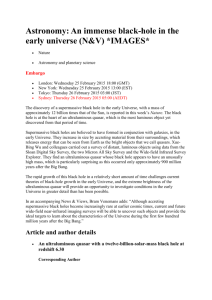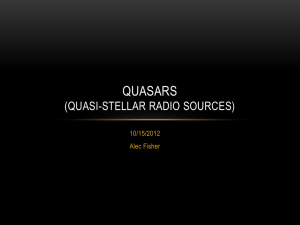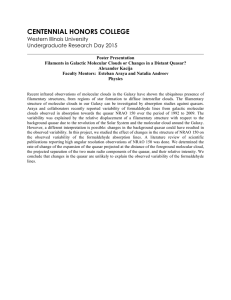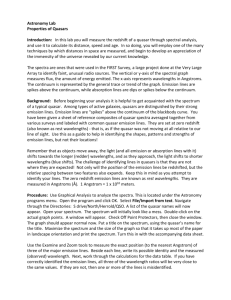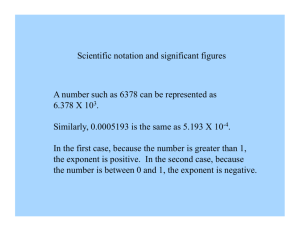What is the fine-structure constant? W
advertisement
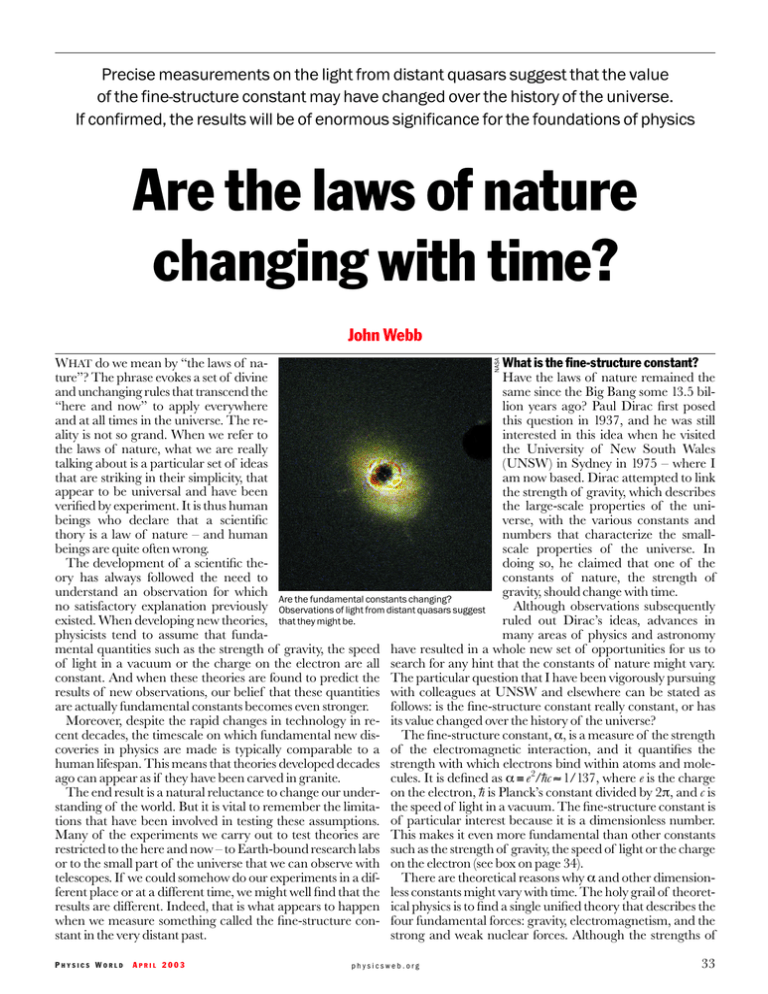
Precise measurements on the light from distant quasars suggest that the value of the fine-structure constant may have changed over the history of the universe. If confirmed, the results will be of enormous significance for the foundations of physics Are the laws of nature changing with time? John Webb NASA WHAT do we mean by “the laws of naWhat is the fine-structure constant? ture”? The phrase evokes a set of divine Have the laws of nature remained the and unchanging rules that transcend the same since the Big Bang some 13.5 bil“here and now” to apply everywhere lion years ago? Paul Dirac first posed and at all times in the universe. The rethis question in 1937, and he was still ality is not so grand. When we refer to interested in this idea when he visited the laws of nature, what we are really the University of New South Wales talking about is a particular set of ideas (UNSW) in Sydney in 1975 – where I that are striking in their simplicity, that am now based. Dirac attempted to link appear to be universal and have been the strength of gravity, which describes verified by experiment. It is thus human the large-scale properties of the unibeings who declare that a scientific verse, with the various constants and thory is a law of nature – and human numbers that characterize the smallbeings are quite often wrong. scale properties of the universe. In The development of a scientific thedoing so, he claimed that one of the ory has always followed the need to constants of nature, the strength of understand an observation for which Are the fundamental constants changing? gravity, should change with time. no satisfactory explanation previously Observations of light from distant quasars suggest Although observations subsequently existed. When developing new theories, that they might be. ruled out Dirac’s ideas, advances in physicists tend to assume that fundamany areas of physics and astronomy mental quantities such as the strength of gravity, the speed have resulted in a whole new set of opportunities for us to of light in a vacuum or the charge on the electron are all search for any hint that the constants of nature might vary. constant. And when these theories are found to predict the The particular question that I have been vigorously pursuing results of new observations, our belief that these quantities with colleagues at UNSW and elsewhere can be stated as are actually fundamental constants becomes even stronger. follows: is the fine-structure constant really constant, or has Moreover, despite the rapid changes in technology in re- its value changed over the history of the universe? cent decades, the timescale on which fundamental new disThe fine-structure constant, α, is a measure of the strength coveries in physics are made is typically comparable to a of the electromagnetic interaction, and it quantifies the human lifespan. This means that theories developed decades strength with which electrons bind within atoms and moleago can appear as if they have been carved in granite. cules. It is defined as α ≡ e 2/hc ≈ 1/137, where e is the charge The end result is a natural reluctance to change our under- on the electron, h is Planck’s constant divided by 2π, and c is standing of the world. But it is vital to remember the limita- the speed of light in a vacuum. The fine-structure constant is tions that have been involved in testing these assumptions. of particular interest because it is a dimensionless number. Many of the experiments we carry out to test theories are This makes it even more fundamental than other constants restricted to the here and now – to Earth-bound research labs such as the strength of gravity, the speed of light or the charge or to the small part of the universe that we can observe with on the electron (see box on page 34). There are theoretical reasons why α and other dimensiontelescopes. If we could somehow do our experiments in a different place or at a different time, we might well find that the less constants might vary with time. The holy grail of theoretresults are different. Indeed, that is what appears to happen ical physics is to find a single unified theory that describes the when we measure something called the fine-structure con- four fundamental forces: gravity, electromagnetism, and the strong and weak nuclear forces. Although the strengths of stant in the very distant past. PHYSICS WORLD APRIL 2003 physicsweb.org 33 1 Simulated quasar absorption spectrum Constants with and without dimensions galaxy quasar to Earth signal (arbitrary units) hydrogen absorption due to galaxy 3500 4000 emission lines from the quasar heavy-element absorption due to galaxy 4500 5500 5000 observed wavelength (Å) 6000 Quasars are highly luminous objects that emit light over a wide range of wavelengths (red line), with peaks at several wavelengths due to emission by elements such as hydrogen, nitrogen, silicon, carbon and iron in the gas around the quasar. When light from the quasar passes near a galaxy on its way to Earth, the gas around the galaxy causes a distinct pattern of absorption lines in the quasar spectrum (green line). By measuring the wavelengths of the absorption lines due to heavy elements (on the right of the figure) we can determine both the redshift of the gas and the value of the fine-structure constant, α, at the time when the light from the quasar was absorbed. Such observations suggest that the value of α was slightly smaller billions of years ago. The plethora of absorption features at the shorter wavelengths on the left are due to hydrogen at different redshifts. these four forces differ, as do the distances over which they operate, most physicists believe that a unified theory will be discovered. If such a theory is not found, a great deal of the elegance and beauty of fundamental physics will be lost. Einstein’s theory of gravity – the general theory of relativity – only requires three spatial dimensions. However, the leading contender for a unified theory requires extra dimensions beyond our familiar three. We do not know if these unified theories are correct, but if extra dimensions do exist, they must be tiny compared with our ordinary spatial dimensions. The concept of attributing a “size” to a dimension may seem strange but it is important. The current size of the universe is determined by the distance that light has travelled since the Big Bang (i.e. about 13.5 billion light-years) and by the amount by which it has expanded since then. This means that the actual size of the universe is about 40 billion lightyears and rising. Are the extra dimensions predicted by unified theories also expanding at the same rate as the universe? The answer to this question is no. If the tiny extra dimensions were expanding at this rate, then the strength of gravity would also be changing very rapidly, and there is no evidence for this. However, it may be possible to infer the presence of these extra dimensions – if they exist – by detecting small changes in the strength of gravity or the other three forces. It has been predicted, for instance, that “large” extra dimensions might cause small deviations in the inverse-square law of gravity over distances of less than 1 mm. However, recent measurements by John Price and co-workers at the University of Colorado at Boulder have failed to find any evidence for this over distances of about 100 µm ( J C Long et al. 2003 Nature 421 922). This is just one of many experiments that have been set up to perform high-precision tests on constants, forces and fundamental symmetries in recent years. 34 Nature presents us with various constants. Some of these constants, such as the fine-structure constant, are dimensionless and are not expressed in terms of units. However, other constants, such as the velocity of light or the mass of the proton, are dimensional and their numerical values depend entirely on the units in which they are expressed. The laws of nature do not, of course, depend on a man-made system of units. To put this another way, if we want to measure a dimensional constant, we need a “yardstick” to make the measurement. But if we obtained one value when we measured the speed of light on a Monday, say, and a different value when we measured it on a Friday, how would we know that our yardstick had not shrunk or expanded? We would not. Moreover, if we were to interpret our observations as a change in the length of the yardstick, how could we verify it without reference to a second yardstick? Again, we could not. And so on. However, dimensionless constants are fundamental absolute numbers, measured without reference to anything else. Therefore, if we want to investigate if the laws of nature are changing we must measure dimensionless quantities such as the fine-structure constant or the ratio of the electron and proton masses. There are several ways to measure possible changes in α with time. We can measure the absorption spectra of quasars at different redshifts, as we have done at UNSW. We can compare the “ticking rates” of atomic clocks made of different elements (see box on page 36). We can also study the cosmic microwave background or the creation of the elements in the early universe. However, one of the first methods used to probe how α might have changed over the past two billion years relies on what must be one of the most unusual processes ever studied by physicists – the so-called natural nuclear reactor at Oklo in Central Africa. The strange story of the Oklo reactor Natural uranium contains two isotopes. Uranium-235, the isotope that is useful for nuclear energy, is relatively rare and accounts for just 0.7% of all natural uranium. Its less-radioactive sibling, uranium-238, makes up the other 99.3%. In 1972 scientists from the French atomic energy commission noticed something mysterious in soil samples taken from a uranium mine in Gabon in Central Africa: the relative abundance of uranium-235 was a factor of two lower than expected. One possibility was that a band of hi-tech terrorists had been stealing and stockpiling the missing uranium for purposes even more evil than blowing up innocent atolls. However, isotopes of various other elements also appeared to be depleted in a pattern that was strikingly similar to that observed among the waste products from modern nuclear reactors. The most plausible explanation is that there must once have been a “natural” nuclear reactor at Oklo. Although natural nuclear reactors were predicted by Paul Kuroda of the University of Arkansas as long ago as 1956, Oklo is the only known example (see photograph opposite). What appears to have happened is that oxygenated water slowly dissolved the uranium-235 that was stored in surface rock about two billion years ago. Back then the natural concentration of uranium-235 would have been about 3% – it is much lower now because uranium-235 decays about six times faster than uranium-238. Over time the uranium-235 physicsweb.org PHYSICS WORLD APRIL 2003 ANDREAS MITTLER Natural wonder – measurements obtained at the natural nuclear reactor at Oklo in Central Africa can place limits on any possible change in the value of the fine-structure constant over the past two billion years. would have become concentrated in nearby algae mats, which acted as filters, and eventually enough of it would have collected to reach criticality and form a natural nuclear reactor. This reactor would have “burned” the uranium-235, thus explaining the low levels of the isotope found at Oklo. But what has this got to do with α? In 1976, four years after the Oklo reactor was discovered, Alexander Shlyakhter of the Leningrad Nuclear Physics Institute made the connection. Samples from Oklo revealed a relative abundance of samarium-149 that was a factor of 45 lower than other terrestrial samples and Shlyakhter showed that ambient neutrons could convert samarium-149 into samarium-150 if they had exactly the right energy. This resonance was due to a delicate balance between the strong nuclear force and the repulsive electromagnetic force in samarium. Moreover, the resonance energy depended on α, so if the value of α was different two billion years ago, then the depletion of samarium-149 would also have been different. The details of the calculation are complicated, but they show that any fractional change in the value of α since the time that Oklo was active cannot be greater than 10–7 (see Olive et al. in further reading). Very recently a new geological measurement technique known as “rhenium dating” has produced potentially even more stringent results. The ages of iron meteorites obtained using rhenium dating are consistent with those found by other methods. From this we can show that the beta-decay lifetime of rhenium cannot have changed by more than 0.5% over the age of the solar system. This translates to an upper limit on any fractional change in the value of α of the order 10–7 over about 4.6 billion years. While 4.6 billion years is a long time, the universe itself is about 13.5 billion years old. Is it possible to test for changes in the value of α even earlier in the history of the universe? The answer is yes – with the help of quasars. as it was just over eight minutes ago because that is how long it takes the light from the Sun to reach the Earth. Similarly, some quasars are so far away that we see them as they were billions of years ago. Indeed, by observing quasars we can build up a continuous “universal history” that starts when the universe was only about one billion years old and continues up to the present day. However, we cannot study α with any reasonable precision using the quasars themselves. Rather, we must examine what happens when the radiation from a quasar passes through a galaxy that lies between the Earth and the quasar. The quasar emits light over a broad range of wavelengths (figure 1). However, when this light passes through the gas around the galaxy, a characteristic pattern of absorption lines will be superimposed on it. The presence of an absorption line at a particular wavelength reveals that a specific element is present in the gas cloud, and the width of each line shows the quantity of the element that is present. In addition to hydrogen, which is ubiquitous in the universe, these “bar codes” reveal that the gas clouds contain a range of other elements, including magnesium, iron, zinc, silicon, aluminium and chromium. Moreover, the bar code reveals what was happening when the light passed through the cloud, which could have happened as long ago as just one billion years after the Big Bang. Although the gas cloud would have evolved into something quite different by today, its bar code provides us with a permanent imprint of its state in the distant past – including information about the value of α at that time. Therefore, if we compare the bar codes that we find in quasar absorption spectra with the bar codes we measure for the same atoms and ions in the laboratory, we can find out if the physics that is responsible for the absorption of radiation by atoms has changed over the history of the universe. In other words, we can find out if α has changed. Using quasars to look at the fine-structure constant Quasars are compact but highly luminous objects. Indeed, they are so luminous that they can be studied in intricate detail using ground-based telescopes despite being vast distances away from us. We think that quasars contain black holes at their centres and that the immense gravitational force exerted by the black hole is extremely efficient at converting matter in its vicinity into light. Nature kindly co-operates by scattering quasars throughout the universe. Since quasars are seen in all directions in the sky, they provide a powerful way of charting almost the entire universe. And, like any astronomical object, whenever we look at a quasar we see it as it was in the past. We see the Sun Back to the laboratory Back in 1998 I began collaborating with my colleagues Victor Flambaum and Vladimir Dzuba at UNSW and John Barrow, now at Cambridge University in the UK. Although both Victor and I worked in the same department, neither of us had been aware of a common interest until he discovered that I was looking for a student to help me in my efforts to use quasars to explore whether α had been different in the past. The advantage of pooling his theoretical expertise with my experimental work quickly became apparent as we realized that we could improve the precision of the measurements of α by an order of magnitude by analysing existing astrophysical data in a new way. PHYSICS WORLD APRIL 2003 physicsweb.org 35 Searching for changes in the fine-structure constant using atomic clocks John Harrison would not have believed the precision of the latest atomic clocks. Despite his mechanical genius, a clock made out of atoms – rather than cogs and springs – would surely surprise him. The H4 clock with which Harrison eventually won the £20 000 prize offered by the Board of Longitude in 1714 for a solution to the problem of finding longitude at sea was accurate to 39 seconds over 47 days, or 1 part in 105. However, the latest atomic clocks are accurate to one second in 50 million years, or 1 part in 1015. This level of accuracy makes it possible to search for any variations in the fine-structure constant over timescales of years. The world’s most precise atomic clocks are now made from “atomic fountains”. A gas of atoms within a vacuum chamber is trapped by a set of intersecting laser beams and cooled to a temperature close to absolute zero. The ball of atoms is then tossed vertically into the air by changing the frequency of the lasers and it passes through a microwave cavity on its way up and also on its way down as it falls under gravity. The whole process is then repeated. Another laser beam is used to make the atoms fluoresce, and the amount of fluorescence is measured as a function of the microwave frequency to plot a “resonance curve”. An ultra-precise measurement of time can be made by measuring the frequency of the peak in this resonance curve (see “Atomic clocks” by Pierre Lemonde in Physics World January 2001 pp39–44). It turns out that the width of the resonance curve is inversely proportional to the time that it takes for the atoms to pass through the microwave cavity, so the curve becomes narrower as the atoms spend longer in the cavity. This allows the position of the peak to be determined more precisely, which means that the clock becomes more accurate. This is why physicists are keen to place an atomic fountain in space: “micro-gravity” conditions will extend the time by a factor of 10, with a Prior to our work, α had been measured by looking at “alkali doublet” lines in systems such as singly ionized magnesium (Mg II). This ion has a single electron in its outer shell and its first excited energy level is split into a doublet as a result of interactions between the orbital and spin angular momenta of the electron. The energy difference between the two states in the doublet is proportional to α2. Indeed, “fine structure” is defined as the splitting of energy levels due to interactions between the orbital and spin angular momenta. This fine-structure splitting means that Mg II absorbs light at two slightly different frequencies when it is excited from its ground state to the first excited state. In the laboratory these wavelengths are 2796 Å and 2803 Å. The expansion of the universe means that the wavelengths observed in quasar spectra, λobs, are longer by a factor that depends on the red36 corresponding increase in the precision of the clock. But what has this got to do with the fine-structure constant, α? It is not surprising to find that the resonance frequency relies on α. Moreover, if α is changing with time, clocks made from different elements will “tick” at slightly different rates. Therefore, by comparing the stability of two clocks made of different elements it should be possible to place an upper limit on any variation of α with time. Unlike the quasar and Oklo results, experiments with atomic clocks probe the stability of α as it is today rather than billions of years ago. A recent experiment by Harold Marion and coworkers at the Observatoire de Paris and the Ecole Normale Supérieure (ENS) compared the rates of cesium and rubidium fountain clocks over a fiveyear period. If α is changing, the rate of change, 1/α (dα/dt), must be less than –0.4 ± 16 × 10–16 per year (see further reading). This is not in conflict with the Oklo or quasar results. The European Space Agency has plans to fly an atomic-clock experiment – called the Atomic Clock Ensemble in Space (ACES) – on the International Space Station. In addition to various tests of general relativity, ACES will be 100 times more sensitive to changes in α than terrestrial experiments. ACES will comprise two atomic clocks: a cesium clock called PHARAO (see photograph) built by a team led by Christophe Salomon of the ENS and Andre Clairon of the Observatoire de Paris, and a hydrogen maser built by Alain Jornod of the Observatoire Cantonal de Neuchâtel in Switzerland. The ACES experiment is particularly exciting for my colleagues and me because it might be able to detect a drift in the value of α, which would confirm our quasar results. On the other hand, ACES may find no change. However, this will not show that the quasar results are wrong because the two experiments probe vastly different times and α could be changing at very different rates in these different epochs. Moreover, the rate of change may also depend on other factors, such as the local gravitational potential. shift of the gas: λobs = (1 + z)λ, where z is the redshift and λ is the original wavelength. The change in the absorption spectrum caused by the redshift and that caused by any change in α are different and can be separated out. Whereas the effect of the redshift is to multiply the wavelength of every line in the spectrum by the name number, 1 + z, any variation in α only changes the relative separation between the lines in the doublet. However, the alkali-doublet approach fails to take advantage of one crucial physical aspect. When an atom or ion is in its ground state, the electrons spend a lot more time close to the nucleus than they do when the atom is in an excited state. Since α essentially defines the strength of the interaction between the nucleus and the electrons, any change in α will have a greater impact on the atom or ion when in its ground state. physicsweb.org PHYSICS WORLD APRIL 2003 2 How spectral lines shift ∆α/α 0 AIII SiII SiII FeII NiII AI III Zn II Cr II What could produce a spurious signal in the data? Fe II Fe II Mg II Mg I –0.5 1.0 2500 2000 3000 rest wavelength (Å) To check if the value of the fine-structure constant, α, has changed over the history of the universe it is necessary to compare the wavelength of various absorption lines in quasar spectra, after redshift effects have been removed, with the corresponding wavelengths as measured in the laboratory. The top (green) line in this figure shows the position of various absorption lines in atoms and ions of silicon (Si), iron (Fe), aluminium (Al), zinc (Zn), chromium (Cr) and magnesium (Mg) as measured in the laboratory. Mg I is neutral magnesium, Mg II is singly ionized magnesium (i.e. a Mg+ ion) and so on. The wavelengths of these lines depend on α in different ways, and the coloured lines show where the absorption lines would be if α was smaller in the past than it is today. The red line corresponds to a value of α that is 90% of the current value (i.e. ∆α/α = –0.1), green corresponds to 80%, and so on. Notice how some atoms hardly change as α varies (e.g. silicon), whereas others shift towards longer wavelengths (e.g. iron) or shorter wavelengths (zinc). This observation is important because it means that it would be hard for effects other than a variation in α to mimic this pattern. 1500 But the alkali-doublet method uses just a single atomic species, so it measures change relative to the same ground state and so misses out on this advantage. For these reasons, Victor, Vladimir Dzuba and I developed a method to use different sets of atomic absorption lines and compare wavelengths relative to different ground states. After we realized that comparing laboratory and quasar observations in this way would provide a huge increase in sensitivity, the challenge was to compute to a reasonable precision how the energy of an electron in its ground state changed for a given change in α. Once we had that information, we could then translate any differences between the laboratory and quasar measurements into a value for, or a upper limit on, any possible change in the value of α. A further advantage of this “many-multiplet” approach is that light elements, such as magnesium, do not react strongly to a change in α, whereas heavier elements such as iron do. This means that the light elements can be used as “anchors” against which we can measure changes in heavier elements (figure 2). However, when we first tried to apply the many-multiplet approach to real astrophysical data we got a big shock. The high-resolution spectrographs on the world’s largest telescopes were able to measure wavelengths in quasar spectra more accurately than they had ever been measured in the laboratory. In other words, we knew more about the fine structure of atoms 12 billion years ago than we did today, and our efforts to look for changes in α were immediately limited by the old experimental data. It was therefore necessary to begin a series of brand new PHYSICS WORLD APRIL 2003 We have spent a great deal of time and effort trying to answer this question and make sure that the results we have seen are due to a change in the value of α and not something else. We have even written an entire paper summarising all the possible sources of error and quantifying them one by one (see Murphy et al. in further reading). After an exhaustive study we came up with only two possible experimental effects that could significantly influence the results. One concerned the dispersion of light from the quasar as it passed through the Earth’s atmosphere. Light at each end of the optical spectrum is dispersed by a different amount, since the refractive index of any medium depends on frequency. A sophisticated application of what is high-school physics allows us to compute the importance of this effect, with the conclusion that it is unable to explain the results we find. A second and more subtle effect concerns the relative amounts of different isotopes of the same elements in the quasar spectra and the laboratory spectra. Terrestrial samples of magnesium, for example, contain 79% magnesium-24, 10% magnesium-25 and 11% of magnesium-26. What if the gas clouds contain different relative abundances of these isotopes? Again, we have looked at this effect in detail and it is unable to explain the quasar results. In fact, averaged over the whole quasar sample, we find that any attempt to include these effects in our interpretation of the quasar data is likely to make the results even more statistically significant. laboratory experiments to re-measure the wavelengths of all the absorption lines seen in the quasar spectra. Much of this experimental work was carried out by Anne Thorne and Juliet Pickering at Imperial College in London and the data are now so accurate that there is no longer a significant error due to laboratory measurements in the quasar results. The observations have been carried out by many astronomers, including Chris Churchill of Penn State University, Jason Prochaska and Michael Rauch of the Carnegie Observatories in Pasadena, Art Wolfe of the University of California at San Diego, and Tom Barlow, Rob Simcoe and Wal Sargent at the California Institute of Technology, while John Barrow at Cambridge has also been very active in the theoretical interpretation of the results. A great deal of work has been done by Michael Murphy, who recently completed his PhD with me at UNSW and is now at Cambridge. Stephen Curran and, very recently, Panayiotis Tzanivaris have also joined the project at UNSW. Since the project started in 1998 we have measured 75 quasars at distances out to 13 billion light-years with the 10 metre Keck 1 telescope on Hawaii. The results from the Keck 1 data are astonishing. There is statistically significant evidence that α may have been very slightly smaller in the past, but only by about 1 part in 105 (see figure 3). We have explored many different possible sources of errors but they cannot explain what we find (see box on page 37). We are aware, however, that all our data come from the same instrument, the HIRES spectrograph on Keck 1, and we are therefore keen to analyse data from other instruments and telescopes, such as the European Southern Observatory’s magnificent Very Large Telescope (VLT). New quasar data are beginning to flow from the VLT – a set of four 8 metre telescopes in Chile – and we should soon be able to tell whether the same signal appears in those data. physicsweb.org 37 3 Results from quasar spectra ∆α/α 0 –1 –2 0 1 2 3 redshift When the fractional change in the fine-structure constant, ∆α/α, is plotted as a function of redshift, we find that the value of α appears to have been slightly smaller (by about 1 part in 105) in the past than it is now. Each of the green data points in the figure corresponds to an average of about 10 independent quasar measurements, and the redshifts range from z = 0.55 (about 5.6 billion years ago) to z = 3 (about 12.6 billion years ago). If α was not changing over the history of the universe then the data points would be scattered about the horizontal dashed line (see Webb et al. in further reading). Other groups are also joining the hunt. John Bahcall of the Institute for Advanced Studies in Princeton and colleagues have just completed an exceptionally thorough analysis based on a new approach in which they studied oxygen emission lines from distant galaxies. Although Bahcall and co-workers took enormous care to select only the highest quality data for their analysis, the precision they finally reach is about an order of magnitude less than we obtained using the many-multiplet methods on quasar absorption spectra. This means that they have not yet been able to provide a test of our results (see further reading). If the new data do not confirm the results so far, the combined data from Keck 1 and the VLT will nevertheless place the most stringent constraints so far on the form that new unified theories of the fundamental forces must take. And if the new data support a changing α, we may eventually have to rewrite significant portions of modern physics. What does it all mean? It should be noted that the present status of all these experiments is one of consistency. For example, the geological results do not conflict with the quasar results or the atomicclock experiments because they probe very different epochs in the history of the universe. It is possible that the value of α was changing relatively rapidly (by 1 part in 105) in the first few billion years after the Big Bang, and that the fractional change has been 100 times smaller since the time of the Oklo reactor about two billion years ago. We cannot repeat the Oklo “experiment” but the results from the quasar observations and the atomic-clock experiments will become increasingly accurate over the next few years. Confirmation that α is changing would have profound implications for physics. For instance, the equivalence principle – one of the cornerstones of relativity – states that in freely falling reference frames, the outcome of any non-gravitational experiment is independent of when and where it is carried out. Changes in the value of α would constitute a violation of the equivalence principle. However, this is not necessarily bad news because many of the theories that seek to unify the four fundamental forces of nature also violate the equivalence principle. The varying speed of light (VSL) theories, first proposed by John Moffat of the University of Toronto and developed in recent years by João Magueijo of Imperial College, John Barrow and others as an alternative to inflationary models in cosmology, could also lead to changes in the value of α in the early universe. Inflation and VSL theories are both attempts to explain various features of the universe – such as its apparent flatness – that cannot be explained by the Big Bang theory alone. If the quasar results are eventually confirmed, our concepts of space and time are sure to undergo radical transformations. Who knows how this will change our fundamental understanding of the universe? Further reading The early universe We can also search for variations in α at even earlier times in the history of the universe. If we change α, we change the temperature at which electrons and protons recombined in the early universe to form neutral hydrogen atoms: this is the process that defines the formation of the cosmic microwave background about 380 000 years after the Big Bang (see “The cosmic microwave background” by Pedro G Ferreira on page 27 and Martins et al. in further reading). A change in α would change the time at which recombination occurred, and this could be detected by satellite measurements of the cosmic background. The formation of light elements such as helium, deuterium and lithium in the first few minutes after the Big Bang would also be affected if α was changing over time. The equations that define the rate at which the light elements are formed are modified in different ways if α varies over time. This means that accurate measurements of the relative abundances of these elements can also be used to constrain any change in α over almost the entire history of the universe – from the first few minutes after the Big Bang until today (see Bergström et al. in further reading). Both of these methods are not yet very accurate. Nevertheless they provide important complementary constraints on any variations of α and show that it cannot have changed by much more than 10% in either case. 38 J N Bahcall, C L Steinhardt and D Schlegel 2003 Does the fine-structure constant vary with cosmological epoch? arXiv.org/abs/astro-ph/0301507 J Barrow 2002 The Constants of Nature (Jonathan Cape, London) J D Bekenstein 2003 Fine-structure constant variability: surprises for laboratory atomic spectroscopy and cosmological evolution of quasar spectra arXiv.org/abs/astro-ph/0301566 L Bergström, S Iguri and H Rubinstein 1999 Constraints on the variation of the fine-structure constant from big bang nucleosynthesis Phys. Rev. D 60 045005 C J A P Martins et al. 2003 WMAP constraints on varying α and the promise of reionization arXiv.org/abs/astro-ph/0302295 H Marion et al. 2003 A search for variations of fundamental constants using atomic fountain clocks arXiv.org/abs/physics/0212112 M T Murphy et al. 2002 Does the fine-structure constant vary? A detailed investigation into systematic effects arXiv.org/abs/astro-ph/0210532 K A Olive et al. 2002 Constraints on the variations of the fundamental couplings arXiv.org/abs/hep-ph/0205269 J-P Uzan 2002 The fundamental constants and their variation: observational status and theoretical motivations arXiv.org/abs/hep-ph/0205340 J K Webb et al. 2001 Further evidence for cosmological evolution of the fine-structure constant Phys. Rev. Lett. 87 091301 J K Webb et al. 2002 Does the fine-structure constant vary? A third quasar absorption sample consistent with varying alpha arXiv.org/abs/ astro-ph/0210531 John Webb is in the School of Physics, University of New South Wales, Sydney, NSW 2052, Australia, e-mail jkw@bat.phys.unsw.edu.au physicsweb.org PHYSICS WORLD APRIL 2003
